Related Research Articles

The Holy See, also called the See of Rome, Petrine See or Apostolic See, is the central governing body of the Catholic Church and the Vatican City State. It encompasses the office of the pope as the bishop of the Apostolic episcopal see of Rome and serves as the spiritual and administrative authority of the worldwide Catholic Church and the city-state. Under international law, the Holy See holds the status of a sovereign juridical entity.
Pope Benedict VI was the bishop of Rome and ruler of the Papal States from 19 January 973 to his death in 974. His brief pontificate occurred in the political context of the establishment of the Holy Roman Empire, during the transition between the reigns of Otto I and Otto II, incorporating the struggle for power of Roman aristocratic families such as the Crescentii.

Pope Victor III, was the head of the Catholic Church and ruler of the Papal States from 24 May 1086 to his death. He was the successor of Pope Gregory VII, yet his pontificate is far less notable than his time as Desiderius, the great abbot of Monte Cassino.
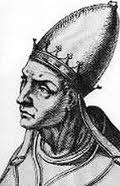
Pope Leo VIII was a Roman prelate who claimed the Holy See from 963 until 964 in opposition to John XII and Benedict V and again from 23 June 964 to his death. Today, he is considered by the Catholic Church to have been an antipope during the first period and the legitimate Pope during the second. An appointee of Holy Roman Emperor Otto I, Leo VIII's pontificate occurred after the period known as the saeculum obscurum.

The Holy Roman Emperor, originally and officially the Emperor of the Romans during the Middle Ages, and also known as the Romano-German Emperor since the early modern period, was the ruler and head of state of the Holy Roman Empire. The title was held in conjunction with the title of King of Italy from the 8th to the 16th century, and, almost without interruption, with the title of King of Germany throughout the 12th to 18th centuries.

The Papal States, officially the State of the Church, were a conglomeration of territories on the Italian Peninsula under the direct sovereign rule of the Pope from 756 to 1870. They were among the major states of Italy from the 8th century until the Unification of Italy, which took place between 1859 and 1870, and culminated in their demise.

Pope Nicholas II, otherwise known as Gerard of Burgundy, was the head of the Catholic Church and ruler of the Papal States from 24 January 1059 until his death in 27 July 1061. At the time of his election, he was bishop of Florence. During his Papacy, Nicholas II successfully expanded the influence of the papacy in Milan and southern Italy. He was also responsible for passing papal election reforms.

The Archbasilica of Saint John Lateran is the Catholic cathedral of the Diocese of Rome in the city of Rome, and serves as the seat of the bishop of Rome, the pope. The only "archbasilica" in the world, it lies outside of Vatican City proper, which is located approximately four kilometres northwest. Nevertheless, as properties of the Holy See, the archbasilica and its adjoining edifices enjoy an extraterritorial status from Italy, pursuant to the terms of the Lateran Treaty of 1929. Dedicated to the Christ, in honor of John the Baptist and John the Evangelist, the place name, Laterano (Lateran) comes from an ancient Roman family (gens), whose palace (domus) grounds occupied the site; the adjacent Lateran Palace was the primary residence of the pope until the Middle Ages.
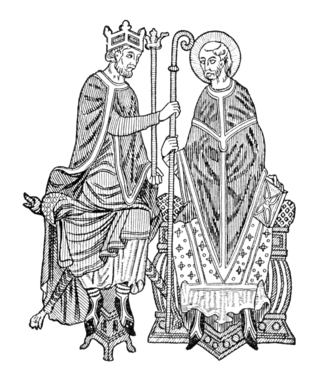
The Investiture Controversy or Investiture Contest was a conflict between the Church and the state in medieval Europe over the ability to choose and install bishops (investiture) and abbots of monasteries and the pope himself. A series of popes in the 11th and 12th centuries undercut the power of the Holy Roman Emperor and other European monarchies, and the controversy led to nearly 50 years of conflict.

The Guelphs and Ghibellines were factions supporting respectively the Pope and the Holy Roman Emperor in the Italian city-states of Central Italy and Northern Italy during the Middle Ages. During the 12th and 13th centuries, rivalry between these two parties dominated political life across medieval Italy. The struggle for power between the Papacy and the Holy Roman Empire arose with the Investiture Controversy, which began in 1075 and ended with the Concordat of Worms in 1122.

The Sack of Rome, then part of the Papal States, followed the capture of Rome on 6 May 1527 by the mutinous troops of Charles V, Holy Roman Emperor, during the War of the League of Cognac. Charles V only intended to threaten military action to make Pope Clement VII come to his terms. However, most of the Imperial army were largely unpaid. Despite being ordered not to storm the city, they broke into the scarcely defended city and began looting, killing, and holding citizens for ransom without any restraint. Clement VII took refuge in Castel Sant'Angelo after the Swiss Guard were annihilated in a delaying rear guard action; he remained there until a ransom was paid to the pillagers.
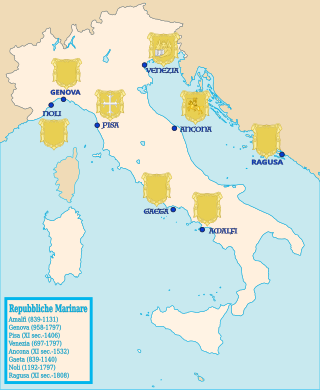
The history of Italy in the Middle Ages can be roughly defined as the time between the collapse of the Western Roman Empire and the Italian Renaissance. Late antiquity in Italy lingered on into the 7th century under the Ostrogothic Kingdom and the Byzantine Empire under the Justinian dynasty, the Byzantine Papacy until the mid 8th century. The "Middle Ages" proper begin as the Byzantine Empire was weakening under the pressure of the Muslim conquests, and most of the Exarchate of Ravenna finally fell under Lombard rule in 751. From this period, former states that were part of the Exarchate and were not conquered by the Lombard Kingdom, such as the Duchy of Naples, became de facto independent states, having less and less interference from the Eastern Roman Empire.
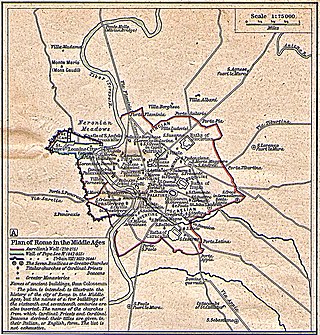
The Leonine City is the part of the city of Rome which, during the Middle Ages, was enclosed with the Leonine Wall, built by order of Pope Leo IV in the 9th century.

According to Roman Catholicism, the history of the papacy, the office held by the pope as head of the Catholic Church, spans from the time of Peter to the present day.
Alberic I was the Lombard Duke of Spoleto from between 896 and 900 until 920, 922, or thereabouts. He was also Margrave of Camerino, and the son-in-law of Theophylact I, Count of Tusculum, the most powerful man in Rome.

The Kingdom of Italy, also called Imperial Italy, was one of the constituent kingdoms of the Holy Roman Empire, along with the kingdoms of Germany, Bohemia, and Burgundy. It originally comprised large parts of northern and central Italy. Its original capital was Pavia until the 11th century.
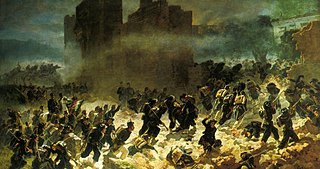
The Capture of Rome occurred on 20 September 1870, as forces of the Kingdom of Italy took control of the city and of the Papal States. After a plebiscite held on 2 October 1870, Rome was officially made capital of Italy on 3 February 1871, completing the unification of Italy (Risorgimento).

The 1061 papal election was held on 30 September 1061 in San Pietro in Vincoli in Rome, following the death of Pope Nicholas II. In accordance with Nicholas II's bull, In Nomine Domini, the cardinal bishops were the sole electors of the pope for the first time in the history of the Roman Catholic Church. Bishop Anselmo de Baggio of Lucca, a non-cardinal and one of the founders of the Pataria, was elected Pope Alexander II and crowned at nightfall on 1 October 1061 in San Pietro in Vincoli Basilica because opposition to the election made a coronation in St. Peter's Basilica impossible.

With a long history as a vantage point for anti-popes forces threatening Rome, Viterbo became a papal city in 1243. During the later thirteenth century, the ancient Italian city of Viterbo was the site of five papal elections and the residence of seven popes and their Curias, and it remains the location of four papal tombs. These popes resided in the Palazzo dei Papi di Viterbo alongside the Viterbo Cathedral intermittently for two decades, from 1257 to 1281; as a result, the papal palace in Viterbo, with that in Orvieto, are the most extensive thirteenth-century papal palaces to have survived.
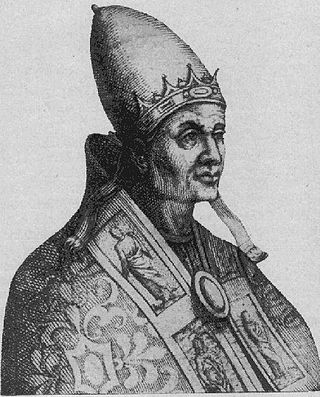
The Tusculan Papacy was a period of papal history from 1012 to 1048 where three successive relatives of the counts of Tusculum were installed as pope.
References
- ↑ Partner, Peter (2023-11-15). The Lands of St Peter: The Papal State in the Middle Ages and the Early Renaissance. Univ of California Press. p. 256. ISBN 978-0-520-32258-5.
- ↑ Memorie istoriche della città di Fano raccolte, e pubblicate da Pietro-Maria Amiani. Parte prima [-seconda] (in Italian). 1751. p. 203.